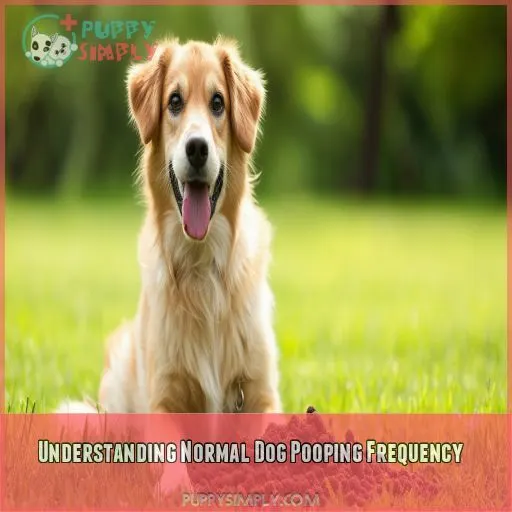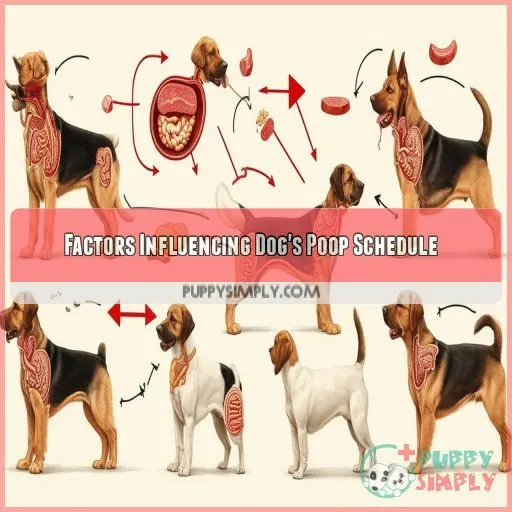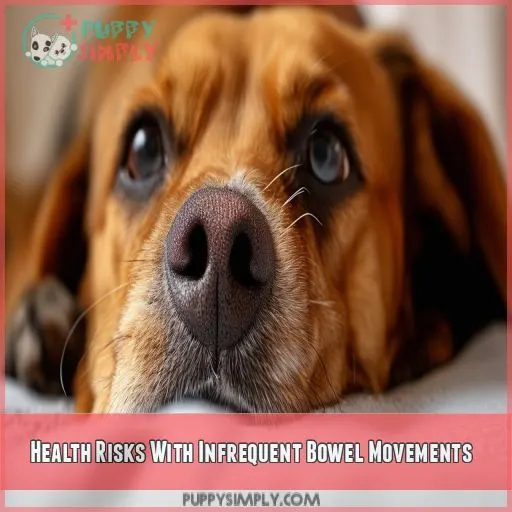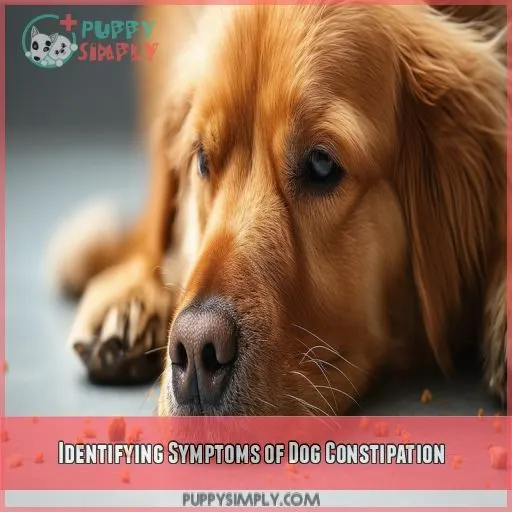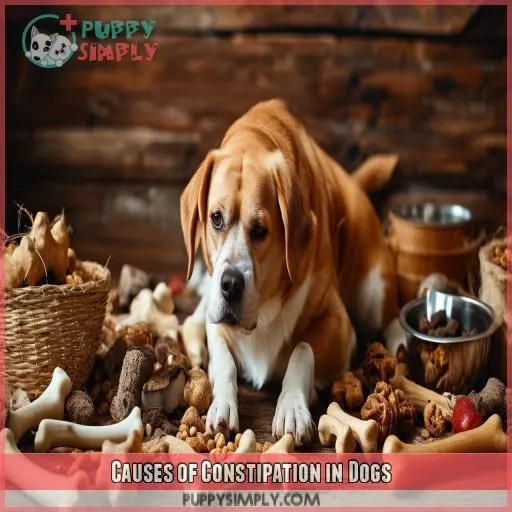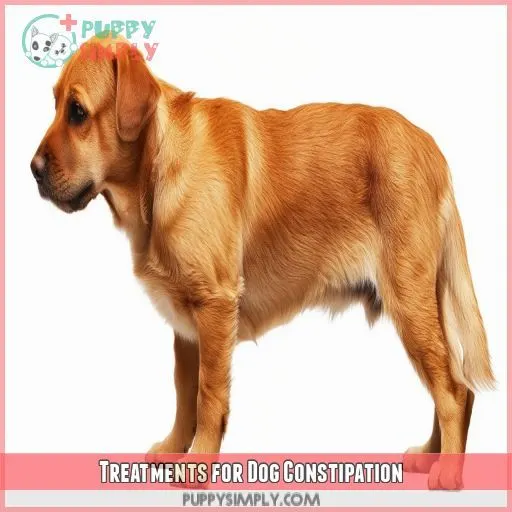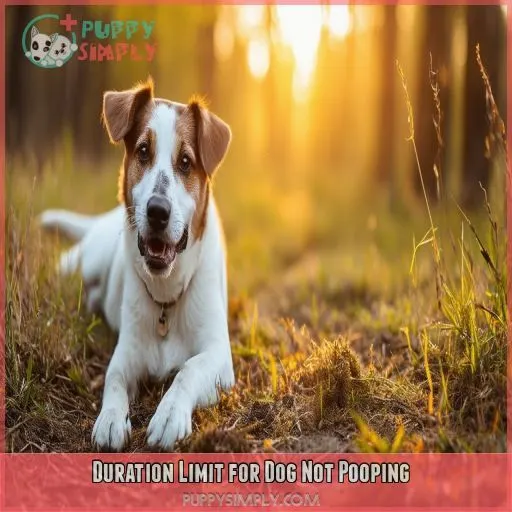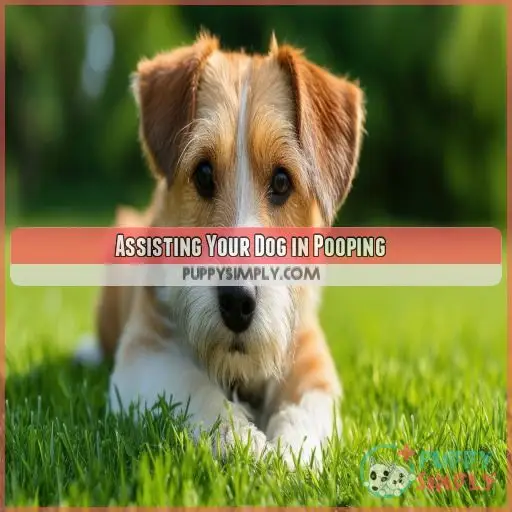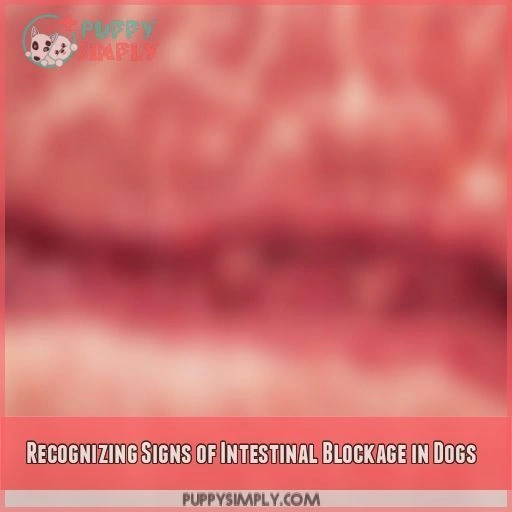This site is supported by our readers. We may earn a commission, at no cost to you, if you purchase through links.
 When nature’s call goes unanswered, you might wonder: how long can a dog go without pooping? As a concerned pet parent, it’s natural to worry about your furry friend’s digestive health.
When nature’s call goes unanswered, you might wonder: how long can a dog go without pooping? As a concerned pet parent, it’s natural to worry about your furry friend’s digestive health.
While most dogs typically relieve themselves once or twice daily, various factors can affect their schedule. Understanding your pup’s normal habits and recognizing signs of constipation are imperative.
This guide offers vet-approved tips to help you navigate your dog’s bathroom routine and know when it’s time to seek professional help.
Table Of Contents
- Key Takeaways
- How Long Can a Dog Go Without Pooping?
- Understanding Normal Dog Pooping Frequency
- Factors Influencing Dog’s Poop Schedule
- Health Risks With Infrequent Bowel Movements
- Identifying Symptoms of Dog Constipation
- Causes of Constipation in Dogs
- Treatments for Dog Constipation
- Duration Limit for Dog Not Pooping
- Assisting Your Dog in Pooping
- Recognizing Signs of Intestinal Blockage in Dogs
- Frequently Asked Questions (FAQs)
- How long is too long for a dog to not poop?
- How do I help my dog poop?
- How do I tell if my dog is constipated or has a blockage?
- How long can a dog hold its poop?
- Can diet changes affect a dogs pooping frequency?
- Do certain dog breeds poop less often than others?
- How does aging impact a dogs bowel movement patterns?
- Can stress or anxiety cause a dog to stop pooping?
- Is it normal for puppies to poop more frequently?
- Conclusion
Key Takeaways
- Don’t worry, it’s not a marathon: Most dogs poop once or twice a day, but don’t panic if your pup skips a day; their schedule can vary, just like humans.
- Constipation can be a pain: If your dog hasn’t pooped in 48 hours, take action. Signs like straining, dry stools, or a grumpier attitude indicate constipation.
- Fiber to the rescue: Add canned pumpkin or stool softeners to their diet to keep things moving, but don’t overdo it to avoid a diarrhea disaster!
- Exercise is essential: A brisk walk or play session stimulates your dog’s digestive system, helping keep their bowels regular, just like in humans.
How Long Can a Dog Go Without Pooping?
Dogs typically poop between one and two times per day. Puppies and dogs on high-fiber diets may poop more frequently.
If your dog hasn’t pooped in a while, several factors could be responsible, including diet and emotional health.
Constipation, dehydration, and intestinal obstruction are potential health risks associated with infrequent bowel movements in dogs.
Understanding Normal Dog Pooping Frequency
Understanding your dog’s pooping habits is essential for their health. Most dogs poop 1-2 times daily, but this can vary. Puppies tend to go more frequently, especially after meals. Large breeds might have less frequent bowel movements, sometimes every other day.
If you’ve switched to a high-fiber diet, don’t be surprised if your pup’s pooping frequency increases to 3 times a day. Keep an eye on consistency and color too. It’s a good idea to accompany your dog outside to monitor their habits.
While occasional changes aren’t usually cause for alarm, no bowel movement for over 24-36 hours could signal constipation or an intestinal blockage. This can lead to dehydration and other health risks.
Factors Influencing Dog’s Poop Schedule
Your dog’s poop schedule is influenced by several factors, including diet, exercise, health conditions, and stress levels. Understanding these elements can help you better monitor your pet’s digestive health and identify potential issues early on.
Diet’s Impact on Bowel Movements
Your dog’s diet plays a critical role in their pooping frequency. High-fiber foods can increase dog pooping frequency, while low-fiber diets may lead to constipation.
Dehydration can also cause dog pooping problems, so make sure your pup has plenty of water.
Sudden changes in diet can disrupt your dog’s digestive system, affecting their poop schedule. To maintain healthy dog poop, introduce new foods gradually and stick to a consistent feeding routine.
Exercise and Physical Activity Influence
Exercise plays a vital role in your dog’s poop schedule. Regular physical activity stimulates the digestive system, promoting healthy bowel movements.
A sedentary lifestyle can lead to constipation, while consistent exercise helps maintain a regular pooping routine.
Combine exercise with proper hydration and a balanced diet to keep your furry friend’s digestive system running smoothly.
Role of Health Conditions and Medications
Your dog’s health conditions and medications can notably influence their pooping habits. Chronic conditions, digestive disorders, and even certain medications may alter your furry friend’s bathroom routine. Here are some factors to note:
- Allergies and intolerances causing digestive upset
- Tumors affecting the digestive tract
- Medication side effects slowing down bowel movements
- Chronic conditions like hypothyroidism affecting metabolism
Understanding these influences can help you better manage your dog’s health and prevent constipation-related issues.
Emotional and Environmental Factors
Your dog’s pooping habits can be affected by emotional and environmental factors. Stress, anxiety, and routine changes may disrupt their normal schedule.
If you’ve recently moved or altered your dog’s environment, you might notice changes in their pooping patterns. Keep an eye out for signs of distress, like holding in poop or straining while pooping.
Maintaining a consistent routine and providing a calm environment can help regulate your dog’s bathroom habits.
Health Risks With Infrequent Bowel Movements
Infrequent bowel movements in dogs can lead to serious health risks like constipation, dehydration, and intestinal obstruction. Watch for signs such as straining during defecation, dry or hard stools, decreased appetite, and abdominal discomfort, and consult your vet if you notice these symptoms in your dog.
Common Risks Associated
When your dog experiences infrequent bowel movements, it’s essential to be aware of potential health risks. These can range from mild discomfort to serious complications. Here are three common risks associated with prolonged constipation:
- Intestinal parasites
- Diet-induced constipation
- Blockages from foreign objects
Stress and allergies can also play a role in disrupting your dog’s digestive system. Remember, if your pup’s poop becomes hard and compacted, it’s time to take action. Don’t let your furry friend suffer in silence!
Signs and Symptoms in Dogs
If your dog’s pooping habits change, keep an eye out for these red flags: straining, whining when trying to poop, or producing hard, dry stools. You might notice changes in consistency or color, and in severe cases, blood. Dehydration is another concern.
Don’t panic though – treatments like canned pumpkin or stool softeners can help.
If you spot enlarged anal glands or persistent issues, it’s time to consult your vet.
Identifying Symptoms of Dog Constipation
If your dog is constipated, you’ll notice them holding in poop, straining while trying to go, or whining during attempts to defecate. Additionally, their stools may appear hard and compacted, indicating difficulty in passing them normally.
Holding in Poop
Your dog’s reluctance to poop can be a sign of constipation. Watch for these telltale signs:
- Frequent squatting without producing stool
- Unusual poop accidents in the house
- Avoiding their usual potty spots
- Changes in stools, like small, hard pellets
These behaviors might disrupt puppy housetraining or indicate digestive health issues. Remember, how long a dog can go without pooping varies, but if it’s been over 48 hours, consult your vet. They may recommend changes in exercise, diet, or even dog prescription food.
Straining While Pooping
If you notice your dog straining while pooping, it’s a clear sign of constipation. This discomfort can lead to pain and other health issues if left untreated. Here’s a quick guide to help you understand and address this problem:
| Symptom | Possible Cause | Treatment |
|---|---|---|
| Hunched posture | Dehydration | Increase water intake |
| Frequent squatting | Lack of fiber | Add pumpkin to diet |
| Small, hard stools | Blockage | Consult a vet immediately |
Don’t ignore these signs; early intervention can prevent more serious complications.
Whining During Defecation
If your dog’s straining progresses to whining during defecation, it’s a clear sign of discomfort. This vocalization indicates pain or anxiety associated with the act.
Your furry friend might be experiencing stress due to constipation or other digestive issues. Pay attention to these sounds, as they’re your dog’s way of communicating distress.
Don’t ignore this symptom, as it could signal a more serious underlying problem.
Hard and Compacted Stools
If your dog’s whining progresses, you might notice hard, compacted stools. This is a telltale sign of constipation. The poop will be dry, small, and difficult to pass. It’s like your dog’s trying to squeeze out a rock!
Constipation causes can range from dietary issues to dehydration. Treatment options include home remedies like pumpkin or dietary adjustments.
Causes of Constipation in Dogs
Your dog’s constipation can stem from various factors, including imbalances in fiber intake, matted fur around the anal area, enlarged anal glands, or ingestion of foreign objects. Understanding these potential causes can help you identify the root of your dog’s constipation and take appropriate action to alleviate their discomfort.
Fiber Intake Imbalances
Your dog’s fiber intake can greatly impact their digestive health. Excessive or insufficient fiber in their diet can result in constipation. Monitor your pup’s bowel movements, as they provide insight into their overall well-being. Consider these fiber-related factors:
- Insufficient fiber may hinder digestion
- Excessive fiber can cause hard, dry stools
- Abrupt dietary changes can disrupt the gut’s balance
Adjust your dog’s fiber intake gradually to find the proper balance for their unique needs.
Matted Fur Concerns
You mightn’t think your dog’s fur affects their bathroom habits, but matted fur can be a hidden culprit behind constipation.
During shedding season, fur can become tangled, especially around the hindquarters. This matting can physically obstruct your pup’s ability to poop comfortably.
Regular grooming routines are essential for maintaining both fur and skin health, preventing this uncomfortable issue and keeping your dog’s digestive system running smoothly.
Enlarged Anal Glands
Matted fur isn’t the only culprit behind your dog’s constipation. Enlarged anal glands can also be a pain in the rear.
These small sacs near your pup’s bottom can become impacted, causing discomfort and difficulty pooping.
Watch for scooting, excessive licking, or a fishy odor – telltale signs of anal gland issues.
Don’t worry, though. Your vet can easily express the glands, providing quick relief.
Ingestion of Foreign Objects
While enlarged anal glands can cause discomfort, ingestion of foreign objects poses a more serious risk. Your dog’s curiosity might lead to intestinal obstruction if they swallow non-food items. This can result in:
- Impacted stool and severe constipation
- Abdominal discomfort and pain
- Dehydration due to blocked digestion
Watch for signs like vomiting, lethargy, or loss of appetite. If you suspect foreign body ingestion, don’t wait—contact your vet immediately to prevent potentially life-threatening complications.
Treatments for Dog Constipation
If your dog is experiencing constipation, there are several effective treatments you can try at home. These include adding canned pumpkin to their diet, using stool softeners, increasing exercise, switching to a prescription diet, or in severe cases, considering enema procedures under veterinary guidance.
Canned Pumpkin as a Solution
Canned pumpkin can be a natural remedy for your dog’s constipation. It’s packed with fiber, which helps regulate digestion.
Start with a small dosage, about 1-4 tablespoons depending on your dog’s size. While generally safe, too much can cause diarrhea.
If you don’t have canned pumpkin, sweet potato or squash can be alternatives.
Always check with your vet before introducing new foods to your pup’s diet.
Stool Softeners for Relief
If canned pumpkin doesn’t do the trick, you might consider stool softeners for your constipated pup. Over-the-counter options and safe laxatives can provide relief. Here are some home treatments and natural remedies to try:
- Mineral oil mixed with food
- Psyllium husk powder
- Coconut oil in small amounts
- Mild vegetable or olive oil
- Dietary changes like increased water intake
Always consult your vet before trying new treatments, as they’ll know what’s best for your furry friend’s specific situation.
Increasing Exercise Benefits
While stool softeners can help, increasing your dog’s exercise is another effective way to combat constipation. Regular physical activity stimulates bowel movements and improves overall digestive health. Here’s a quick guide to help you get started:
| Exercise Type | Frequency | Duration |
|---|---|---|
| Walks | Daily | 15-30 min |
| Fetch | 2-3x/week | 10-15 min |
| Swimming | 1-2x/week | 10-20 min |
Start with low-intensity exercises and gradually increase duration and intensity. Remember, every dog’s needs are different, so consult your vet for personalized advice.
Prescription Diet Options
If exercise isn’t enough, your vet may recommend prescription diet options. These specially formulated foods can help regulate your dog’s digestive system and alleviate constipation. Prescription brands offer various options designed to meet specific needs:
- High-fiber diets to promote regular bowel movements
- Low-residue foods for sensitive stomachs
- Hydration-focused formulas to combat dehydration-related constipation
These prescription diets can be a game-changer for your furry friend’s digestive health, offering targeted solutions to get things moving again.
Enema Procedures
If your dog’s constipation persists, your vet might recommend an enema. This procedure involves introducing fluid into the rectum to stimulate bowel movements.
While effective, it’s essential to follow your vet’s instructions carefully. Never attempt an enema at home without professional guidance, as improper use can lead to complications.
Risks include dehydration and electrolyte imbalances. Always prioritize your dog’s safety and comfort when considering this treatment option.
Duration Limit for Dog Not Pooping
You’re probably wondering how long your furry friend can go without doing their business. While it’s normal for dogs to skip a day occasionally, you shouldn’t let them go more than 48 hours without pooping. After this point, health risks like constipation and intestinal blockages become a real concern.
The duration can vary based on factors such as diet, exercise, and overall health. If your dog hasn’t pooped in over two days, it’s time to take action.
Consider potential causes like dietary issues or lack of exercise, and try some at-home treatments like increasing fiber intake or encouraging more physical activity. However, if these methods don’t work, don’t wait too long to seek professional help.
Assisting Your Dog in Pooping
If your dog’s been holding it in, you’ll want to take action. Start by adjusting their diet. Special diets high in fiber can help get things moving. Remember, breed differences matter – what works for a Chihuahua might not suit a Great Dane.
Exercise is key, too. A brisk walk or play session can stimulate bowel movements. For senior dogs, gentle massages around the abdomen can help.
Don’t forget the emotional impact of constipation; your furry friend might be stressed or anxious. Patience and a calm environment can work wonders. If you’re still toilet training, maintain a consistent schedule.
Finally, try the squatting technique: gently lift your dog’s back legs while they’re in position. This mimics their natural posture and can encourage pooping.
If these methods don’t work, it’s time to consult your vet.
Recognizing Signs of Intestinal Blockage in Dogs
While aiding your dog in defecation is essential, it’s equally imperative to recognize indicators of intestinal blockage. This grave condition can arise if your furry companion ingests something inappropriate.
Be vigilant for abdominal pain, which may manifest as a hunched posture or aversion to being touched. Vomiting is another warning sign, particularly if it’s frequent or contains blood. You may observe a decline in your dog’s appetite or energy levels. Constipation or diarrhea can also signal a blockage.
If you encounter these symptoms, don’t hesitate – contact your veterinarian promptly. Time is of the utmost importance when addressing intestinal obstructions.
Frequently Asked Questions (FAQs)
How long is too long for a dog to not poop?
You should be concerned if your dog hasn’t pooped in 48-72 hours. It’s too long if they’re showing signs of discomfort, straining, or exhibiting unusual behavior. Always monitor your pup’s habits and consult a vet if you’re worried.
How do I help my dog poop?
To help your dog poop, increase fiber in their diet with canned pumpkin or fiber supplements. Make sure they’re hydrated and exercising regularly. Try a gentle belly massage or a warm bath. If constipation persists, consult your vet for professional advice.
How do I tell if my dog is constipated or has a blockage?
Constipation in dogs is rare, but if they’re straining, whimpering, or have a swollen belly, it could be a blockage. Other signs include vomiting, loss of appetite, and passing blood. If you’re concerned, consult a vet.
How long can a dog hold its poop?
Healthy adult dogs can hold their poop for 8 to 12 hours if they’ve to, but they may start to feel uncomfortable. Puppies can hold their poop for one hour per month of age, up to a maximum of 8 hours when they’re 8 months old.
Can diet changes affect a dogs pooping frequency?
Yes, diet changes can affect a dog’s pooping frequency. A switch to a healthier, whole food diet with fresh ingredients can lead to less frequent and firmer stools. During a changeover, you may notice softer stools and changes in frequency as bacteria adapt.
Do certain dog breeds poop less often than others?
Yes, the frequency of a dog’s bowel movements can vary depending on their breed size. Smaller dogs tend to poop more often than larger breeds.
How does aging impact a dogs bowel movement patterns?
As dogs age, they may experience changes in their bowel movements due to factors like decreasing muscle tone, lower digestive efficiency, dietary changes, and medical issues. Keep an eye on your dog’s toilet habits and consult a vet if you notice anything unusual.
Can stress or anxiety cause a dog to stop pooping?
Yes, stress and anxiety can cause a dog to stop pooping. Adrenaline affects dogs similarly to humans, and stressful situations can speed up intestinal emptying time, leading to diarrhea.
Is it normal for puppies to poop more frequently?
Yes, it’s normal for puppies to poop more frequently than adult dogs. This is because their intestines are still developing, so food moves through their digestive tract faster.
Conclusion
The bottom line is that if your dog hasn’t pooped in a while, you need to take action.
As a pet parent, it’s crucial to be vigilant about your furry friend’s digestive health.
Understanding your pup’s normal habits and recognizing the signs of constipation are key.
Now that you understand the factors influencing poop schedules and are aware of potential health risks and treatment options, you can navigate your dog’s bathroom habits like a pro.
Remember: If your dog hasn’t pooped in 48–72 hours, seek professional help.

